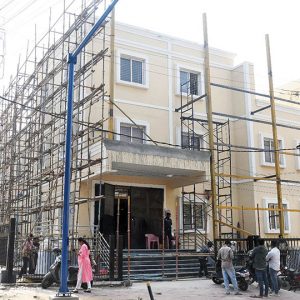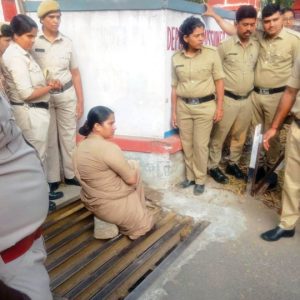- Title: Rama Bhima Soma: Cultural Investigations into Modern Karnataka
- Author: Srikar Raghavan
- Year: 2025
- Pages: 598
- Price: Rs. 587
- Publisher: Context
By Ravi Joshi, Joint Secretary (Retd.), Cabinet Secretariat
The unusual title of the book hides a fascinating ‘tour de force’ of about 500 years of the cultural history of Karnataka and of Kannada literature. The book ‘Rama Bhima Soma’ is encyclopedic in its scope and includes a brief description of almost all the poets, writers and playwrights that have enriched the cultural ethos of the State.
Not only the author Srikar Raghavan’s reading is so diverse and vast, but also his leaps of imagination from the local to the global and from the mundane to the sublime are equally astonishing. Two examples would suffice:
“Someone throws up a ball into the sky, you wait until it pitches thrice — counted as Rama, Bhima, Soma and then the game begins. Whoever is nearest to the ball grabs and begins hurling it at their choicest target and so on…it forces one to alternate between the self and the other, between power and powerlessness…”
Now comes the unexpected leap when he compares this game to what the anarchist thinker Mikhail Bakunin once called the “continual exchange of mutual, temporary and above all voluntary authority.” Contestation for Power has rarely been depicted, with such irreverence, as a ball game.
Another example is his comparison of an untitled line drawing (merely called Plate # 8) of a seemingly distraught man pushing a cycle rickshaw by K.K. Hebbar to Paul Klee’s painting ‘Angelus Novus’ made famous by the German Philosopher Walter Benjamin (well-known for his book ‘The Work of Art in the Age of Mechanical Reproduction’) who called it ‘The Angel of History.’
Srikar dubs Hebbar’s work as ‘The Common Man of History,’ a more secular and universal symbol than Klee’s angel, who is “forced to mechanically pedal ahead while his mind looks back with bewilderment towards a past that is ambiguous and incomprehensible, mired in blood and suffering, the man is caught impossibly in a no-man’s land between two worlds. As a snapshot of a hopelessly polarised political scenario, it captures the blind attempts of a radical Left to usher in a mechanically imagined future utopia, held back by an equally uncomprehending radical Right that seeks to go back to some imagined glorious past…if it ever existed.”
To thus interpret a mere ‘line-drawing’ of Hebbar as a reflection of our existential condition is acutely insightful and probably unsuspected by the artist.
There are many more such gems in the book which reveal that a young man from our own Agrahara could well become a Gabriel Garcia Marquez, having imbibed the ‘stream of consciousness’ writing. A consciousness that will bloom fully if he takes up writing novels. This book, however, is a reportage of what has happened in the literary and artistic landscape of Karnataka, as he grew up with a pen and notebook in hand, frantically catching up with all those living greats that shaped our collective consciousness.
Any ‘Cultural Investigations into Modern Karnataka’ must first answer the question when exactly ‘modern Karnataka’ begins. The ninth century magnum opus Kavirajamarga is the first text in the Kannada language, says the author. This text seeks to take the ‘desi’ mother-tongue, Kannada and fuse it with the cosmopolitan paradigm of the Sanskrit universe — the Marga. That sets the tone for the first chapter that takes up the Marga-Desi conundrum and the battle of linguistic identities. He notes that by the twelfth century, with the rise of Basavanna and his followers challenging the Brahminical orthodoxy, the triumvirate of ‘Temple, King and Sanskrit’ had become the source of all evils. The subsequent rise of Sharana Sahitya becomes the dominant ‘desi’ challenge to the ‘Marga’ or classical literature.
Explicating the difference further, Srikar notes that “M.M. Kalburgi understands the marga-desi distinction through its content, an alienation from nature, art becoming more pretentious as it moves away from the lives of ordinary people.” D.R. Nagaraj, the astute literary critic, on the other hand, approaches the cognitive phenomenon which goes into the formation of the desi rebellions.
Nagaraj says “it is characterised by cultural naivete, and ahistorical optimism. Because it perceives that it is in a pure state, it assumes that all other forces are out to destroy it. Therefore, it assumes, by default, a confrontational and militant defence vis-à-vis the cosmopolitan, universalist paradigm…Desi-vaada is a simple, attractive answer to the anxiety of post-colonial condition… it is not an argument involving rhetoric, but an argument involving an anxiety.”
Nagaraj’s description of desi-vaada could well be taken as a critique of the rebellions of Bandaya – Sahitya and its socio-psychological moorings.
Limitations of space confine me from describing the wealth of knowledge in the other chapters, so I shall merely reproduce the titles here: ‘Of Attics and Romantics: Literature and Socialism along the Western Ghats (a great tribute to Kuvempu, Gopal Gowda Shantaveri and initial references to U.R. Ananthamurthy, whose name keeps recurring); Art as Life: The Aesthetic Universals of South Canara (this covers the three great Icons of Mangaluru — Shivaram Karanth, K.K. Hebbar and B.V. Karanth); ‘Saakshi’: Journeys of Self Discovery (the new literary magazine that Gopal Krishna Adiga launched in early sixties that began the Navodaya movement with Adiga himself becoming its prodigious poster-boy).
In a Saakshi issue published in 1973, U.R. Ananthamurthy wrote an essay called ‘Bharateeyate’ (Indianness), in which he said: “The most sensitive of us feel doubtful of our innermost feelings. In this state of mind, we either chase the ‘absurd’ or feel that the peasant who worships any random stone (with kumkuma on it) is the most authentic Indian. Camus, Kafka or the peasant — all of them become masks adopted by a mind that has no real foundation.” A brutal but honest self-crtique.
Here Srikar talks about Ananthamurthy’s famous rivalry with another giant of Kannada letters — Dr. S.L. Bhyrappa, remarking that ‘they have always struck me as two brothers fighting for the attention of the mother, and juxtaposing them gives us a fuller picture of the enormous paradoxes at the heart of literary ideology… Bhyrappa never liked the cult of the Saakshi magazine which never really admitted him into its fold. It is a historical coincidence that at the peak of their literary powers the identities of both these writers were forged with their ideological rivalry over thematically coinciding concerns. He cites Ananthamurthy’s Samskara and Bhyrappa’s Vamshavrisksha, published in mid-sixties, as the prime examples of their meditations on the clash between Brahmin orthodoxy and the onset of modernity.
The other chapters are: ‘Lost in Translation: Kannada after ‘Boosa’ (the controversy that erupted after B. Basavalingappa’s irreverential remark about Kannada books being ‘Boosa’ (cow fodder), which was in fact an appeal not to give up the study of English to develop critical thinking.
Srikar rightly notes that this remark became the tipping point that “opened up long-standing fissures in Kannada society. Writers, politicians, students and activists began to voice their responses creating a polarised arena where English was pitted against Kannada, Dalits Vs Upper Castes and the world of letters was suddenly forced into critical reflection.”
Of course, there is much more in the book that must adorn the library of every Kannadiga.
NOTE: Author Srikar Raghavan will be speaking about his debut book at the Mysore Open Forum on 6th April at 10.30 am in Kalpakshetra, Vijayanagar 2nd Stage.








Recent Comments